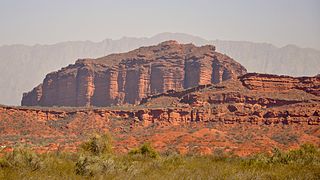
The Los Colorados Formation is a sedimentary rock formation of the Ischigualasto-Villa Unión Basin, found in the provinces of San Juan and La Rioja in Argentina. The formation dates back to the Norian age of the Late Triassic.
The Bushveld Sandstone is a geological formation dating to roughly between 201 and 189 million years ago and covering the Carnian to Norian stages. The Bushveld Sandstone is found in Transvaal, South Africa, and is a member of the Stormberg Group. As its name suggests, it consists mainly of sandstone. Fossils of the prosauropod dinosaur Massospondylus have been recovered from the Bushveld Sandstone.
The Löwenstein Formation is a lithostratigraphic formation of the Keuper in Germany. It is underlain by the Mainhardt Formation and overlain by the Trossingen Formation. It dates back to the middle Norian.

The Trossingen Formation, formerly the Knollenmergel, is a geological formation in Germany and Switzerland. It dates back to the late Norian-Rhaetian.
The Nam Phong Formation, which correlates to the Indosinian III Unconformity, is a geological formation in Thailand. It underlies the Khorat Group. It consists of resistant, red-brown micaceous sandstones, conglomerates, siltstones and mudstones of mainly fluvial origin. The sandstones are medium to very fine-grained and are usually calcareous. The conglomerates contain pebbles of quartz, brown and grey chert, and reddish brown siltstone. Cross bedding and plane-bed stratification are common in the sandstones and conglomerates. The sandstones and conglomerates make up approximately 30% of the formation. This sedimentary rock formation is found in Khon Kaen Province, Thailand. It is of Norian to Rhaetian age to age, and is notable for its fossils of early dinosaurs.
The Argana Group is a Permian to Triassic geological group in the western High Atlas northeast of Agadir, Morocco. Sometimes known as the Argana Formation, it contains eight geological members often divided into three formations. They include the Late Permian Ikakern Formation, the Early Triassic to Carnian Timezgadiouine Formation (T3-T5), and the Late Triassic Bigoudine Formation (T6-T8). Ornithischian tracks are geographically located in Marrakesh province. Indeterminate theropod remains and tracks are geographically located in Marrakesh province.
The Kadzi Formation is a geological formation in Zimbabwe whose strata date back to the Tithonian stage of the Late Jurassic. The conglomeratic sandstones and silty mudstones of the formation were deposited in an alluvial environment. Dinosaur remains are among the fossils that have been recovered from the formation.
The Densuș-Ciula Formation is a geological formation in Romania whose strata date back to the Late Cretaceous. It forms part of the Hațeg Island assemblage. Dinosaur remains are among the fossils that have been recovered from the formation. It is divided up into three members, the lower member is noted for high content of volcanogenic material and is poorly fossiliferous. While the Middle member consists of silty mudstones, sandstones and conglomerates containing volcanogenic clasts and is richly fossiliferous, while the upper member consists of matrix supported red conglomerates and is poorly fossiliferous.
The Ankarafantsika Formation is a Late Cretaceous (Cenomanian) geologic formation of the Mahajanga Basin in the Boeny region of Madagascar, Africa. The fine-grained sandstones of the formation were deposited in a fluvial to lacustrine environment.

The Towaco Formation is a mapped bedrock unit in New Jersey. It is named for the unincorporated village of Towaco, which is near the place its type section was described by paleontologist Paul E. Olsen.

The Feltville Formation is a mapped bedrock unit primarily in New Jersey, with one known outlier in Pennsylvania and another one in New York. It is named for the Deserted Village of Feltville in Watchung Reservation, New Jersey, which is near where its type section was described by paleontologist Paul E. Olsen.
The East Berlin Formation is an Early Jurassic geological formation in New England, United States. Dinosaur footprints and trackways are abundant in this formation. These tracks include Eubrontes, Anchisauripus, and Anomoepus. Several museums, parks, and tourist attractions are based around the East Berlin Formation's dinosaur tracks, including Dinosaur State Park in Rocky Hill, Connecticut and Powder Hill Dinosaur Park in Middlefield, Connecticut.

The Boonton Formation is a mapped bedrock unit in New Jersey, formerly divided between the Boonton and Whitehall beds of the defunct Brunswick Formation. It is named for the town of Boonton, New Jersey, which is near where its type section was described by paleontologist Paul E. Olsen.
The Baños del Flaco Formation is a Late Jurassic to Early Cretaceous (Tithonian to Berriasian geologic formation in central Chile. The formation comprises limestones and sandstones deposited in a shallow marine to fluvial environment. Fossil ornithopod tracks have been reported from the formation.
The Lossiemouth Sandstone is a Middle to Late Triassic age geological formation. It is exposed on the south side of the Moray Firth near Lossiemouth and near Golspie in Sutherland. Dinosaur remains are among the fossils that have been recovered from the formation.
The Bull Run Formation is a Late Triassic (Norian) stratigraphic unit in the eastern United States. Fossil fish bones and scales have been found in outcrops of the formation's Groveton Member in Manassas National Battlefield Park. Indeterminate fossil ornithischian tracks have been reported from the formation.

The Botucatu Formation is an Aptian geologic formation of the Paraná and Pelotas Basins in southern Brazil and northern Uruguay. The formation is composed of quartzitic sandstones, deposited in an eolian environment. Fossil theropod tracks have been reported from the formation.

The Nugget Sandstone is a Late Triassic to Early Jurassic geologic formation that outcrops in Colorado, Idaho, Wyoming, and Utah, western United States.
The Hassberge Formation is a geologic formation in Bavaria, Germany. It preserves fossils dating back to the Carnian stage of the Triassic period.
The Benkersandstein is a geologic formation in Germany. It preserves fossils dating back to the Late Triassic (Carnian) period. Fossil theropod tracks have been reported from the formation.








